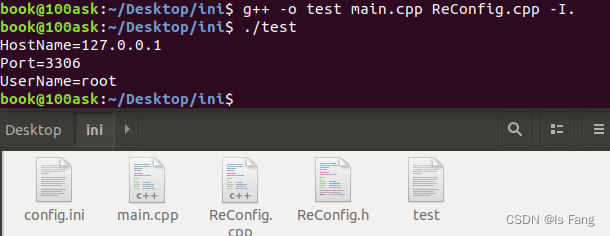读写ini配置文件(C++)
文章转载于:https://blog.csdn.net/weixin_44517656/article/details/109014236
1、为什么要使用ini或者其它(例如xml,json)配置文件?
-
如果我们程序没有任何配置文件时,这样的程序对外是全封闭的,一旦程序需要修改一些参数必须要修改程序代码本身并重新编译,这样很不好,所以要用配置文件,让程序发布后还能根据需要进行必要的配置;
配置文件有很多如INI配置文件,XML配置文件,还有就是可以使用系统注册表等。注意:ini的后缀名也不一定是".ini"也可以是".cfg",“.conf ”或者是”.txt"。因为ini文件实质就是txt文本文件。 -
配置文件除了读取外还可以写入:例如用户设置了习惯模式,这样下次启动读取文件的时候也是该模式
-
kv文件,是ini执行后出现的文件
2、ini文件基本介绍
- .ini 文件是Initialization File的缩写,即初始化文件 [1] ,是windows的系统配置文件所采用的存储格式,统管windows的各项配置,一般用户就用windows提供的各项图形化管理界面就可实现相同的配置了。但在某些情况,还是要直接编辑.ini才方便,一般只有很熟悉windows才能去直接编辑。开始时用于WIN3X下面,WIN95用注册表代替,以及后面的内容表示一个节,相当于注册表中的键。
- 除了windows2003很多其他操作系统下面的应用软件也有.ini文件,用来配置应用软件以实现不同用户的要求。
一般不用直接编辑这些.ini文件,应用程序的图形界面即可操作以实现相同的功能。它可以用来存放软件信息,注册表信息等。
3、ini配置文件的格式
1、INI文件由节、键、值组成。
节:
[section]
参数(键=值)
name=value
注解
注解使用分号表示(;)在分号后面的文字,直到该行结尾都全部为注解。
1)对节进行说明:
- 所有的parameters都是以sections为单位结合在一起的。所有的section名称都是独占一行,并且sections名字都被方括号包围着([ and ])。在section声明后的所有parameters都是属于该section。对于一个section没有明显的结束标志符,一个section的开始就是上一个section的结束,或者是end of the file。Sections一般情况下不能被nested,当然特殊情况下也可以实现sections的嵌套。因为INI文件可能是项目中共用的,所以使用[Section Name]段名来区分不同用途的参数区。
2)对参数进行说明:
- INI所包含的最基本的“元素”就是parameter;每一个parameter都有一个name和一个value,name和value是由等号“=”隔开。name在等号的左边。
3)对注释内容进行说明:
- 在INI文件中注释语句是以分号 “;” 开始的(有些人定义类是由#注释,例如下面的RrConfig)。所有的所有的注释语句不管多长都是独占一行直到结束的,在分号和行结束符之间的所有内容都是被忽略的。
4、C++读写ini配置文件
在VC中涉及的函数有如下四种。
1)读取字符串
//头文件:windows.h
//返回字符串的实际大小,根据系统环境不同失败返回值不同(0或-1)
DWORD GetPrivateProfileString(
LPCTSTR lpAppName, // INI文件中的一个字段名[节名]可以有很多个节名(配置文件的section名),这个字串不区分大小写;
LPCTSTR lpKeyName, // lpAppName 下的一个键名,也就是里面具体的变量名(配置文件的key名),这个字串不区分大小写;
LPCTSTR lpDefault, // 如果lpReturnedString为空,则把这个变量赋给lpReturnedString,一般设为空("");
LPTSTR lpReturnedString, // 存放键值的指针变量,用于接收INI文件中键值(数据)的接收缓冲区
DWORD nSize, // 前一个参数对象lpReturnedString的缓冲区大小
LPCTSTR lpFileName // 完整的INI文件路径名
);
2)读取整型值
UINT GetPrivateProfileInt(
LPCTSTR lpAppName, // INI文件中的一个字段名[节名]可以有很多个节名
LPCTSTR lpKeyName, // lpAppName 下的一个键名,也就是里面具体的变量名
INT nDefault, // 如果没有找到指定的数据返回,则把个变量值赋给返回值
LPCTSTR lpFileName // INI文件的路径
);
3)写入字符串
BOOL WritePrivateProfileString(
LPCTSTR lpAppName, // INI文件中的一个字段名[节名]可以有很多个节名
LPCTSTR lpKeyName, // lpAppName 下的一个键名,也就是里面具体的变量名
LPCTSTR lpString, // 键值,也就是数据
LPCTSTR lpFileName // INI文件的路径
);
4)写入整数值(没有相关函数,可以通过WritePrivateProfileString进行参数转换来实现)
5、 代码示例
由于VC提供的函数部分功能比较少,一般解析配置文件都是调用库或者别人在项目中使用过的类,所以上面只是为了让大家了解ini的格式及相关参数的意义。下面的代码其实不需要看懂,只需要你会用即可。
ReConfig.h文件
#ifndef RR_CONFIG_H_
#define RR_CONFIG_H_
#include <string>
#include <map>
namespace rr
{
class RrConfig
{
public:
RrConfig()
{
}
~RrConfig()
{
}
bool ReadConfig(const std::string & filename);
std::string ReadString(const char* section, const char* item, const char* default_value);
int ReadInt(const char* section, const char* item, const int& default_value);
float ReadFloat(const char* section, const char* item, const float& default_value);
private:
bool IsSpace(char c);
bool IsCommentChar(char c);
void Trim(std::string & str);
bool AnalyseLine(const std::string & line, std::string& section, std::string & key, std::string & value);
private:
//std::map<std::string, std::string> settings_;
std::map<std::string, std::map<std::string, std::string> >settings_;
};
}
#endif
ReConfig.cpp文件
#include "ReConfig.h"
#include <fstream>
#include <stdlib.h>
namespace rr
{
bool RrConfig::IsSpace(char c)
{
if (' ' == c || '\t' == c)
return true;
return false;
}
bool RrConfig::IsCommentChar(char c)
{
switch (c) {
case '#':
return true;
default:
return false;
}
}
void RrConfig::Trim(std::string & str)
{
if (str.empty())
{
return;
}
int i, start_pos, end_pos;
for (i = 0; i < str.size(); ++i) {
if (!IsSpace(str[i])) {
break;
}
}
if (i == str.size())
{
str = "";
return;
}
start_pos = i;
for (i = str.size() - 1; i >= 0; --i) {
if (!IsSpace(str[i])) {
break;
}
}
end_pos = i;
str = str.substr(start_pos, end_pos - start_pos + 1);
}
bool RrConfig::AnalyseLine(const std::string & line, std::string& section, std::string & key, std::string & value)
{
if (line.empty())
return false;
int start_pos = 0, end_pos = line.size() - 1, pos, s_startpos, s_endpos;
if ((pos = line.find("#")) != -1)
{
if (0 == pos)
{
return false;
}
end_pos = pos - 1;
}
if (((s_startpos = line.find("[")) != -1) && ((s_endpos = line.find("]"))) != -1)
{
section = line.substr(s_startpos + 1, s_endpos - 1);
return true;
}
std::string new_line = line.substr(start_pos, start_pos + 1 - end_pos);
if ((pos = new_line.find('=')) == -1)
return false;
key = new_line.substr(0, pos);
value = new_line.substr(pos + 1, end_pos + 1 - (pos + 1));
Trim(key);
if (key.empty()) {
return false;
}
Trim(value);
if ((pos = value.find("\r")) > 0)
{
value.replace(pos, 1, "");
}
if ((pos = value.find("\n")) > 0)
{
value.replace(pos, 1, "");
}
return true;
}
bool RrConfig::ReadConfig(const std::string & filename)
{
settings_.clear();
std::ifstream infile(filename.c_str());//构造默认调用open,所以可以不调用open
//std::ifstream infile;
//infile.open(filename.c_str());
//bool ret = infile.is_open()
if (!infile) {
return false;
}
std::string line, key, value, section;
std::map<std::string, std::string> k_v;
std::map<std::string, std::map<std::string, std::string> >::iterator it;
while (getline(infile, line))
{
if (AnalyseLine(line, section, key, value))
{
it = settings_.find(section);
if (it != settings_.end())
{
k_v[key] = value;
it->second = k_v;
}
else
{
k_v.clear();
settings_.insert(std::make_pair(section, k_v));
}
}
key.clear();
value.clear();
}
infile.close();
return true;
}
std::string RrConfig::ReadString(const char* section, const char* item, const char* default_value)
{
std::string tmp_s(section);
std::string tmp_i(item);
std::string def(default_value);
std::map<std::string, std::string> k_v;
std::map<std::string, std::string>::iterator it_item;
std::map<std::string, std::map<std::string, std::string> >::iterator it;
it = settings_.find(tmp_s);
if (it == settings_.end())
{
//printf("111");
return def;
}
k_v = it->second;
it_item = k_v.find(tmp_i);
if (it_item == k_v.end())
{
//printf("222");
return def;
}
return it_item->second;
}
int RrConfig::ReadInt(const char* section, const char* item, const int& default_value)
{
std::string tmp_s(section);
std::string tmp_i(item);
std::map<std::string, std::string> k_v;
std::map<std::string, std::string>::iterator it_item;
std::map<std::string, std::map<std::string, std::string> >::iterator it;
it = settings_.find(tmp_s);
if (it == settings_.end())
{
return default_value;
}
k_v = it->second;
it_item = k_v.find(tmp_i);
if (it_item == k_v.end())
{
return default_value;
}
return atoi(it_item->second.c_str());
}
float RrConfig::ReadFloat(const char* section, const char* item, const float& default_value)
{
std::string tmp_s(section);
std::string tmp_i(item);
std::map<std::string, std::string> k_v;
std::map<std::string, std::string>::iterator it_item;
std::map<std::string, std::map<std::string, std::string> >::iterator it;
it = settings_.find(tmp_s);
if (it == settings_.end())
{
return default_value;
}
k_v = it->second;
it_item = k_v.find(tmp_i);
if (it_item == k_v.end())
{
return default_value;
}
return atof(it_item->second.c_str());
}
}
main.cpp文件
#include <iostream>
#include "ReConfig.h"
#include <fstream>
#include <cassert>
int main() {
rr::RrConfig config;
bool ret = config.ReadConfig("config.ini");
if (ret == false) {
printf("ReadConfig is Error,Cfg=%s", "config.ini");
return 1;
}
std::string HostName = config.ReadString("MYSQL", "HostName", "");
int Port = config.ReadInt("MYSQL", "Port", 0);
std::string UserName = config.ReadString("MYSQL", "UserName", "");
std::cout << "HostName=" << HostName << std::endl;
std::cout << "Port=" << Port << std::endl;
std::cout << "UserName=" << UserName << std::endl;
return 0;
}
config.ini文件
[MYSQL]
HostName=127.0.0.1
Port=3306
UserName=root
文件路径以及编译结果如图所示:

6、 配置文件的解析库
1)libconfig, C++版本是libconfig++
http://blog.csdn.net/crazyhacking/article/details/9668981
2)C++的Json解析库:jsoncpp和boost .
http://www.cnblogs.com/lidabo/archive/2012/10/31/2748026.html